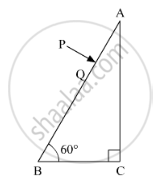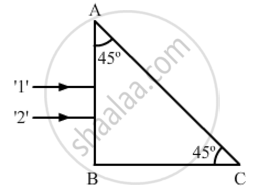Advertisements
Advertisements
Question
A thin prism of crown glass (μr = 1.515, μv = 1.525) and a thin prism of flint glass (μr = 1.612, μv = 1.632) are placed in contact with each other. Their refracting angles are 5.0° each and are similarly directed. Calculate the angular dispersion produced by the combination.
Solution

For crown glass, we have:-
Refractive index for red colour, μcr = 1.515
Refractive index for violet colour, μcv = 1.525
For flint glass, we have:-
Refractive index for red colour, μfr = 1.612
Refractive index for violet colour,μfv = 1.632
Refracting angle, A = 5°
Let:-
δc = Angle of deviation for crown glass
δf = Angle of deviation for flint glass
As prisms are similarly directed and placed in contact with each other, the total deviation produced (δ) is given by
δ = δc + δf
= (μc - 1)A + (μf – 1)A
= (μc + μf – 2)A
For violet light, δv = (μcv + μfv – 2)A
For red light, δr = (μcr + μfr – 2)A
Now, we have:-
Angular dispersion of the combination:-
δv – δr = (μcv + μfv – 2)A – (μcr + μfr – 2)A
= (μcv + μfv – μcr – μfr) A
= (1.525 + 1.632 – 1.515 – 1.612)5
= 0.15°
So, the angular dispersion produced by the combination is 0.15°.
APPEARS IN
RELATED QUESTIONS
Plot a graph to show the variation of the angle of deviation as a function of the angle of incidence for light passing through a prism. Derive an expression for the refractive index of the prism in terms of angle of minimum deviation and angle of the prism.
A ray PQ incident normally on the refracting face BA is refracted in the prism BAC made of material of refractive index 1.5. Complete the path of ray through the prism. From which face will the ray emerge? Justify your answer.

Two monochromatic rays of light are incident normally on the face AB of an isosceles right-angled prism ABC. The refractive indices of the glass prism for the two rays '1' and '2' are respectively 1.38 and 1.52. Trace the path of these rays after entering through the prism.

What is a dispersion of light
A ray of light incident normally on one face of a right isosceles prism is totally reflected, as shown in fig. What must be the minimum value of refractive index of glass? Give relevant calculations.

State any two difference between the primary rainbow and secondary rainbow
Draw the ray diagram showing refraction of light through a glass prism and hence obtain the relation between the refractive index μ of the prism, angle of prism and angle of minimum deviation.
Describe an activity to show that the colours of white light splitted by a glass prism can be recombined to get white light by another identical glass prism. Also, draw a ray diagram to show the recombination of the spectrum of white light.
Give the formula that can be used to determine refractive index of materials of a prism in minimum deviation condition ?
The equation \[\omega = \frac{\mu_u - \mu_r}{\mu - 1}\] was derived for a prism having small refracting angle. Is it also valid for a prism of large refracting angle? Is it also valid for a glass slab or a glass sphere?
A thin prism is made of a material having refractive indices 1.61 and 1.65 for red and violet light. The dispersive power of the material is 0.07. It is found that a beam of yellow light passing through the prism suffers a minimum deviation of 4.0° in favourable conditions. Calculate the angle of the prism.
A thin prism of angle 6.0°, ω = 0.07 and μy = 1.50 is combined with another thin prism having ω = 0.08 and μy = 1.60. The combination produces no deviation in the mean ray. (a) Find the angle of the second prism. (b) Find the net angular dispersion produced by the combination when a beam of white light passes through it. (c) If the prisms are similarly directed, what will be the deviation in the mean ray? (d) Find the angular dispersion in the situation described in (c).
The deviation produced for violet, yellow and red lights for crown glass are 3.75°, 3.25° and 2.86° respectively. Calculate the dispersive power of the crown glass.
In a regular prism, what is the relation between angle of incidence and angle of emergence when it is in the minimum deviation position?
Calculate dispersive power of a transparent material given : nv = 1.56, nr = 1.54, ny = 1.55.
Define angular dispersion.
The refractive indices of material for red, violet and yellow colour light are 1.52, 1.62 and 1.59 respectively.
Calculate the dispersive power of the material. If the mean deviation is 40°. What will be the angular dispersion produced by a prism of this material?
When a ray of white light is incident obliquely on the first surface of a prism, then ______.
What is meant by a thin prism?
